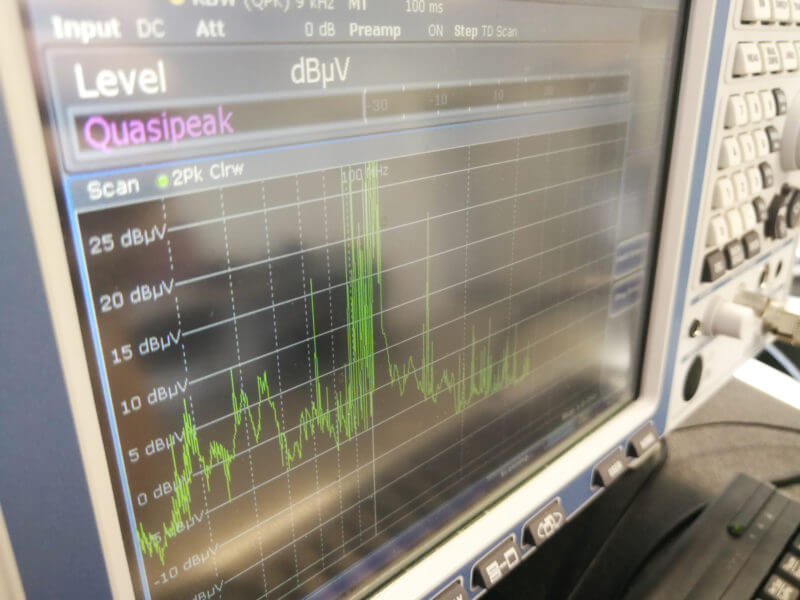
Stories about truckers, in the early days of ABS brakes, discovering that their CB radio could stop a passing car are probably apocryphal. While a powerful radio signal could conceivably induce unwanted signals in a nearby ABS control module, there’s little evidence to support these tales. True or not though, they illustrate the vital importance of electromagnetic compatibility testing.
To prevent unwanted effects, electromagnetic compatibility (EMC) is now governed by a host of national and international regulations. It’s also addressed by just about every builder of cars, trucks, off-road vehicles, boats and even engine-driven power equipment. Many have facilities for carrying out their own EMC tests on finished products, but that’s late in the development process to find component level problems. Partnering with suppliers who can perform appropriate testing on individual devices and subassemblies saves time and minimizes problems with the end product.
EMC: A Double-Sided Problem
Radio signals are a form of electromagnetic radiation. (“Radiation” used in the sense that signals radiate out from a source. They have nothing to do with ionizing radiation.) This radiation could be transient – a brief spike as from a radar system – or continuous, as might be experienced around a high voltage transmission line.
For radio signals, either intentional or accidental, to be a problem there need to be both transmitters or sources and receivers. Thus, builders of electrical and electronic components must ensure their devices do not emit electromagnetic radiation, and they must also prevent susceptibility to its effects.
On the emissions side there are sources outside the vehicle, and also inside. Those external sources include radio transmitters, cellphone towers, powerlines and increasingly, automotive radar systems. Inside, in addition to cellphones and the high voltage ignition arc, there are a growing number of motors, switches and sensors. There’s also as much as 1,000 meters (1,094 yards) of electrical wiring.
Susceptibility to electromagnetic radiation is driven by the presence of antennas. Practically any electrical conductor can act as an antenna with radio signals inducing current flow. The wiring harnesses along with sensors and electronic control modules are all potential receptors of radio signals.
The Role of Testing in Electronic Product Development
It may one day be possible to simulate electromagnetic compatibility testing with sufficient accuracy to replace development testing. For now though, engineers prefer to rely on actual testing. Even if at some point simulation becomes accepted practice, validation testing will remain essential for proving robustness of emission control and immunity to external electrical influences.
Type of Electromagnetic Compatibility Testing
A four-box matrix defines most of the testing needed. The two rows are for radiated and conducted electromagnetic radiation and the columns are for immunity and emissions. Immunity testing entails measuring how the components perform in the presence of electromagnetic radiation, both radiated and conducted. Emission testing is about measuring what electromagnetic radiation is being put out by the components as they operate, again, radiated and conducted.
Two other tests are electrostatic discharge (ESD) and bulk current injection (BCI.). These are to ensure components won’t be damaged by an unexpected spark or by making incorrect electrical connections.
EMC Standards
The primary international standards of relevance to EMC testing are ISO 11452 and CISPR standards 12 and 25. While many engine builders have their own standards, these are derived from the principles established in the ISO and CISPR documents.
ISO 11452 relates to testing components used in cars and passenger vehicles for immunity to narrowband electromagnetic radiation. The CISPR standards, (an abbreviation of Comité International Spécial des Perturbations Radioélectriques,) are somewhat broader, relating to both emission and immunity.
CISPR 12 addresses emissions. Its purpose is to ensure that an engine won’t cause electromagnetic radiation that interferes with watching TV or listening to a radio. CISPR 25 covers the flip side: the immunity of electronic devices used in a vehicle from external sources of interference. For a manufacturer of electronic and electro-mechanical components like Wells Engineered Products, CISPR 25 is the standard of greatest relevance.
The Wells Approach to EMC Testing
Manufacturers of cars, off-road vehicles, power equipment and boats perform EMC testing on the assembled product. Although an important final check, any problems revealed here could delay product launch while they are investigated and resolved.
To avoid such problems, we undertake extensive EMC testing, both throughout the development process and as a final validation test. This ensures the parts supplied meet the relevant standards for emission, immunity, ESD and BCI and will not cause or suffer problems in service.
The test plan agreed with the customer covers the minimum requirements (and usually relates to CISPR and ISO 11452). The extent of testing defined is driven by the nature of the application and where the electronics are to be mounted in the vehicle. Our preference is to do as much testing as possible as early in the development process as possible. The rationale for this is that the earlier any problems are found the easier, faster and less costly it is to put them right.
Ensuring EMC Doesn’t Become a Problem
EMC testing is assuming ever greater importance as radio signals proliferate throughout the environment. Whether driving through a city or along a muddy rural trail, it’s essential that a sudden pulse or continuous emission of radio energy won’t cause the vehicle any problems. Likewise, no one wants their TV viewing or cellphone conversation interrupted by electromagnetic radiation from an engine with defective electrical components.
Thorough EMC testing throughout the product development process, not just at the end, ensures these issues won’t occur. It also helps avoid unexpected, potentially launch-delaying, problems. Partnering with a supplier who understands EMC makes all the difference.
